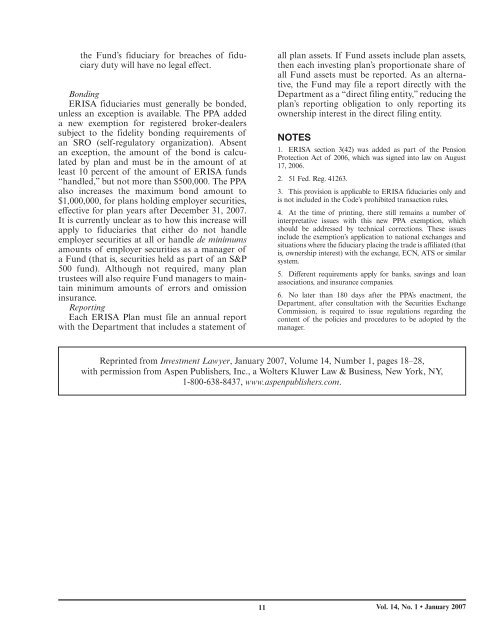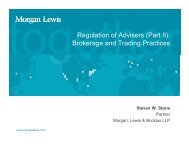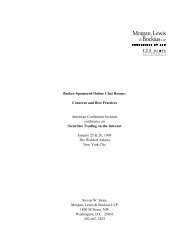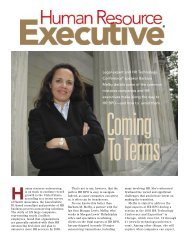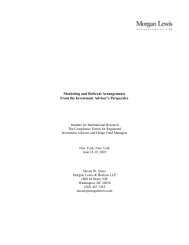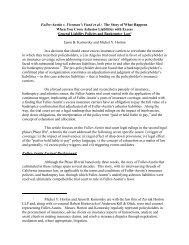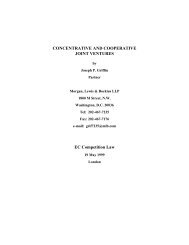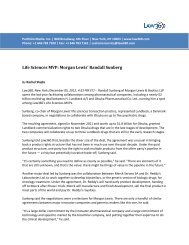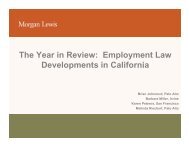What to Do if Your Fund Becomes Subject to ERISA - Morgan, Lewis ...
What to Do if Your Fund Becomes Subject to ERISA - Morgan, Lewis ...
What to Do if Your Fund Becomes Subject to ERISA - Morgan, Lewis ...
You also want an ePaper? Increase the reach of your titles
YUMPU automatically turns print PDFs into web optimized ePapers that Google loves.
the <strong>Fund</strong>’s fiduciary for breaches of fiduciary<br />
duty will have no legal effect.<br />
Bonding<br />
<strong>ERISA</strong> fiduciaries must generally be bonded,<br />
unless an exception is available. The PPA added<br />
a new exemption for registered broker-dealers<br />
subject <strong>to</strong> the fidelity bonding requirements of<br />
an SRO (self-regula<strong>to</strong>ry organization). Absent<br />
an exception, the amount of the bond is calculated<br />
by plan and must be in the amount of at<br />
least 10 percent of the amount of <strong>ERISA</strong> funds<br />
“handled,” but not more than $500,000. The PPA<br />
also increases the maximum bond amount <strong>to</strong><br />
$1,000,000, for plans holding employer securities,<br />
effective for plan years after December 31, 2007.<br />
It is currently unclear as <strong>to</strong> how this increase will<br />
apply <strong>to</strong> fiduciaries that either do not handle<br />
employer securities at all or handle de minimums<br />
amounts of employer securities as a manager of<br />
a <strong>Fund</strong> (that is, securities held as part of an S&P<br />
500 fund). Although not required, many plan<br />
trustees will also require <strong>Fund</strong> managers <strong>to</strong> maintain<br />
minimum amounts of errors and omission<br />
insurance.<br />
Reporting<br />
Each <strong>ERISA</strong> Plan must file an annual report<br />
with the Department that includes a statement of<br />
11<br />
all plan assets. If <strong>Fund</strong> assets include plan assets,<br />
then each investing plan’s proportionate share of<br />
all <strong>Fund</strong> assets must be reported. As an alternative,<br />
the <strong>Fund</strong> may file a report directly with the<br />
Department as a “direct filing entity,” reducing the<br />
plan’s reporting obligation <strong>to</strong> only reporting its<br />
ownership interest in the direct filing entity.<br />
NOTES<br />
1. <strong>ERISA</strong> section 3(42) was added as part of the Pension<br />
Protection Act of 2006, which was signed in<strong>to</strong> law on August<br />
17, 2006.<br />
2. 51 Fed. Reg. 41263.<br />
3. This provision is applicable <strong>to</strong> <strong>ERISA</strong> fiduciaries only and<br />
is not included in the Code’s prohibited transaction rules.<br />
4. At the time of printing, there still remains a number of<br />
interpretative issues with this new PPA exemption, which<br />
should be addressed by technical corrections. These issues<br />
include the exemption’s application <strong>to</strong> national exchanges and<br />
situations where the fiduciary placing the trade is affiliated (that<br />
is, ownership interest) with the exchange, ECN, ATS or similar<br />
system.<br />
5. D<strong>if</strong>ferent requirements apply for banks, savings and loan<br />
associations, and insurance companies.<br />
6. No later than 180 days after the PPA’s enactment, the<br />
Department, after consultation with the Securities Exchange<br />
Commission, is required <strong>to</strong> issue regulations regarding the<br />
content of the policies and procedures <strong>to</strong> be adopted by the<br />
manager.<br />
Reprinted from Investment Lawyer, January 2007, Volume 14, Number 1, pages 18–28,<br />
with permission from Aspen Publishers, Inc., a Wolters Kluwer Law & Business, New York, NY,<br />
1-800-638-8437, www.aspenpublishers.com.<br />
Vol. 14, No. 1 • January 2007


